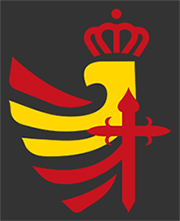MENÚ UNIDAD
ARMY UNITS
- Araba Álava |
- Albacete |
- Alicante |
- Almería |
- Asturias |
- Ávila |
- Badajoz |
- Barcelona |
- Burgos |
- Cáceres |
- Cádiz |
- Cantabria |
- Castellón |
- Ceuta |
- Ciudad Real |
- Córdoba |
- A Coruña |
- Cuenca |
- Girona |
- Granada |
- Guadalajara |
- Gipuzkoa |
- Huelva |
- Huesca |
- Islas Baleares |
- Jaén |
- León |
- Lleida |
- Lugo |
- Madrid |
- Málaga |
- Melilla |
- Murcia |
- Navarra |
- Ourense |
- Palencia |
- Las Palmas |
- Pontevedra |
- La Rioja |
- Salamanca |
- Segovia |
- Sevilla |
- Soria |
- Tarragona |
- Santa Cruz de Tenerife |
- Teruel |
- Toledo |
- Valencia |
- Valladolid |
- Bizkaia |
- Zamora |
- Zaragoza
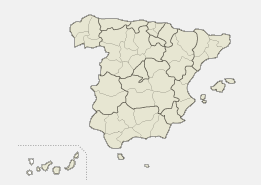
History of the Academy
- pagination
-
The Academia General Militar has a long, successful tradition in the training of Spanish Army officers. The few treatise writers that have thoroughly studied Military training in Spain, such as Clonard or Almirante, conclude that the “Compañía de los Cien Donceles” (Company of the Hundred Young Noblemen), created in 1340 by king of Castile Alfonso XI, appears as the oldest precedent.In the Renaissance Period, the unification of the different kingdoms in Spain and the progress of The Art of the War lead to important tactical and technological innovations which set the basis of the Escuela Militar Española de la Casa de Austria (Spanish Military College of the House of Austria) and the power of the Tercios (the Thirds) throughout the XVIth and XVIIth centuries. Spain was about to create a universal Empire and its maintenance needs required the foundation of Military Colleges or Academies which, under royal protection, dealt with military training and which were located in various places of the Empire (Burgos, Milan, Seville, Barcelona, Lisbon, Orán, Sardinia, etc).The first project to create a Progressive Teaching System, which goes from the general to the specific, was carried out at the end of the XVIIth century, concretely in 1674, in Brussels, where the first modern Military Academy for teaching and training appeared. The Academia Militar del Ejército de los Países Bajos (The Military Academy of the Netherlands) was founded in Brussels by Sebastián Fernández de Medrano, also known as “Second Lieutenant Medrano”. He was a veteran in the Thirds of Flandes and was appointed its Commandant due to his solid scientific and tactical training. This Academy was renowned for the diverse origin of its officer cadets, for the innovative features of its plan of studies, the theoretical and practical basis of its learning process apart from the relevant assignments given to its officer cadets who were also known as the “Great Masters of War”. This center can be considered as the first project of General Military Training as well as the forefather of the future Academia General Militar.These origins act as a guarantor for the comprehensive, evolutionist and varied character that defines our Training Centre which can be considered as a state-of-the-art institution in the developed countries military training.
-
Military Academies
The epoch of the Military Academies goes from 1674 to 1823. The first one, as we have already mentioned, is the Academia del Ejército de los Países Bajos (from 1674 to 1699).The XVIIIth century starts with the Spanish War of Succession which meant the arrival of the Dynasty of the Borbones. Felipe V started a profound reform in the military institution following the French model. The Real Academia de Barcelona (Royal Academy of Barcelona) can be considered as the second project of Centro de Enseñanza General (General Teaching Centre) since it inherits the teaching tradition of the Brussels Academy as it was open by Lieutenant General Jorge Próspero Verboom, outstanding student of this Academy. It was created featuring the one in Brussels to train the most distinguished officers in the peninsula in the Art of War. In 1805 the Academia Especial of the Cuerpo de Ingenieros (Special Academy for the Corps of Engineers) is founded in Alcalá de Henares. In 1805 it is the turn of the Academia de las Armas Generales (Academy of the General Arms) in Zamora, which assumes the tasks of the Academia de Barcelona.
In 1764 Carlos III creates the Real Colegio de Artillería (Royal College of Artillery) in Segovia which although does not comply with the general character of the institution, can be considered as the model to follow due to its pedagogical as well as interior regime systems for the Military Academies in the XIX the century. The Independence War led to diversity and lack of coordination in the Military Academies, thus creating various Military Academies of the different branches. It was Lieutenant Colonel Mariano Gil de Bernabé, from the Artillery branch, who unifies them again in a Military Academy in 1809 based on Batallones Universitarios de Toledo, Granada y Sevilla (the University Battalions). The so called Academia Militar de Cuarto Ejército (1809-1823) adopted the flag called “La Universitaria” and it can be considered the first flag in the Military Academies.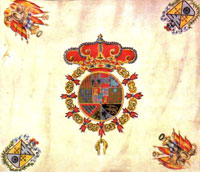
"La Universitaria" Flag
-
Military Colleges
In 1824 an order was issued that established a General Military College divided in sections depending on whether the students were going to join the Infantry, Cavalry, Artillery or Engineers branch. But owing to the interest of the Arms and Corps to train their officers, the Engineers Academy in 1826 and the College of Artillery in 1829 are opened, which broke the idea of College as a unique place for officers’ training.
Lieutenant General Francisco Javier Venegas was appointed Commandant of the Academy and Colonel Mackenna was the second-in-command. The college was placed in Segovia, in the Alcázar, and it was conceived as a boarding school whose plan of studies lasted 5 years. The College started off on 1st June 1825 with great success and was visited by the king annually between 1825 and 1830. In 1837, during the Carlist War, the expedition of General Zaratiegui sieged Segovia and took control of the city and the Alcázar. Then the College of Artillery had to be moved to Madrid and was placed at Convento de Dominicos de Atocha (Dominican Convent of Atocha) and later at Convento de los Trinitarios Descalzos (Convent that belongs to the Barefoot Trinity Order).The disappearance of the Military College in Segovia and the continuation of the Spanish Civil War up until 1840 blurred the work the college had been doing so far and which had the disadvantage of taking a long time in training officers for the Army. This is the reason why the old training system came into effect again: The Milicia Nacional (National Militia), Compañías de Distinguidos y Cadetes de Cuerpo (The Corps of Cadets) revitalized the Arms corporative spirit.In 1842 a Decree signed by Espartero leads to the foundation of the Colegio General de Todas las Armas (General College for all the Branches), that can be regarded as the fifth project in General Military Training. In 1844, its Commandant, Count Clonard, whose name was Serafín María de Sotto, changes its name to Colegio General Militar (General Military College) and moves it to Toledo. The plan of studies consisted of six semesters and established a mixed teaching system that had an initial common cycle in the General College and a second specific cycle in the Special Corps Academies.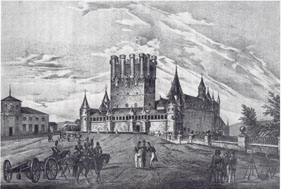
Alcázar de Segovia -
First Epoch
In 1882 the approval of a Royal Decree made the foundation of the Academia General Militar (General Military Academy) in Toledo possible and proposed a military career divided in two parts, a common one that would take place in the Academia General Militar and a second part that would be taught in the Branch Academies. The goal was keeping up with the scientific and technical level dealt with in the Academias de los Cuerpos (Academy of the Corps)as well as improving the future officers’ physical and moral standards. In the Academia General Militar of the first epoch the military model of the Prussian Army and the most innovative pedagogic trends of the moment converge, which leads to the most radical change in the history of military pedagogy. The aim was to train an “Oficial Educador” (Leader Officer), who had to be not only a leader in combat but also a soldier intellectually and morally improved to serve society.
The Academy opens on 15th July 1883 and its first Commandant was General José Galbis Abella. Its first Dean of Academics was Colonel Federico Vázquez Landa, who can be regarded as the very soul of the “Spirit of the General Academy” – “Espíritu de la General”.The Academy was locked up in 1893, and once more a wonderful teaching proposal was cut short. 2,250 Lieutenants that belonged to ten different graduating classes and that had taken part in the wars in Cuba and Morocco had been trained. Of all those soldiers we have to stand out the figure of Miguel Primo de Rivera y Orbaneja, the Academy first General when the Academia General Militar was reopened in Zaragoza.The Academia General Militar’s main contribution was the birth of the “Spirit of the General”, whose meaning enhances the idea of comradeship among all its members built up through the close coexistence of all the students who underwent a hard daily routine and a painstaking moral education.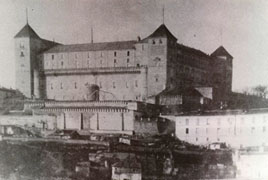
Toledo´s Alcazar 1st Epoch A.G.M. (From Gistau´s book) -
Second Epoch
The Second Epoch goes from 1927 to 1931 and takes place in the city of Zaragoza. During all these years the “Spirit of the General” was still alive but the arrival of General Primo de Rivera as President of the Government in 1923 was decisive since he was aware that most of the problems the Army had to face could be solved with the reopening of the Academia General Militar. It’s the seventh project of General Military Training and Education. On 20th February 1927 War Minister Juan O’Donell Vargas handed the king a decree which permitted the creation of the Academia General Militar in Zaragoza. On January 1928 General Francisco Franco Bahamonde was appointed Commandant of this Academy. He proposed a comprehensive military training that joined technical, physical and moral aspects. The Academy’s Dean of Academics was Miguel Campins Aura who was in charge of embodying the adequate pedagogic frame to carry out the above mentioned type of training. The works to build the Academia General Militar took the Aragonese Mudejar style as its landmark.
The great emphasis and enthusiasm to improve the quality in military education can be observed in the founding Decree, the Internal Regime Regulations and the book “La Academia General Militar de Zaragoza y sus normas pedagógicas” (The Academia General Militar in Zaragoza and its pedagogic rules) by Colonel Campins.Once the Second Republic is proclaimed on 14th April 1931, the War Minister Manuel Azaña signs a Decree that implies dismantling the Academy. He claims different reasons to do so but the most important one is that he finds that both the size and the cost of the Academy are disproportionate. On 14th July General Franco bids farewell to his corps of cadets with a very moving discourse which stands out the value of discipline: ”¡Disciplina!...nunca bien definida y comprendida” (Discipline!, never well-defined and understood).This new attempt to unify military teaching had lasted three years and had included three graduating classes of 740 cadets.
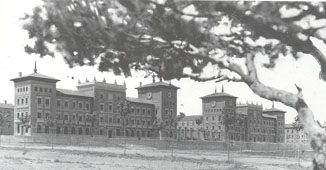
AGM Second Epoch -
Third Epoch
The Third Epoch spans from 1942 to nowadays. A law from 1940 reestablishes the Academia General Militar in Zaragoza aiming at “educar, instruir y preparar moralmente a los futuros Oficiales” (educating and training future officers both from a physical and moral perspective). The priority of education over training is consolidated. The discipline and moral values that constituted the real foundations of “El Espíritu de la General” are still alive in this period and lead all the students’ training. This was the eighth and definitive project of a general military training center. The layouts of the 5 courses which embody the military career vary along this period. The last change took place in the 80s. The Organic Law 11/1983 about University Reform and the dispositions that developed the former, make Act No. 17/89, which stipulates the regulations for professional military personnel, develop a new System of Military Training. It was concluded that the first three years would be studied at the Academia General Militar in Zaragoza and the last two ones at the Branch Academies.
Apart from the training of future Commissioned Officers that belong to the General Arms Corps, the Academia General Militar is also in charge of the training and education of the officers that belong to the Civil Guard. Between 1979 and 1982 the National Police Corps followed a very similar model. The Academy also trains other Army Specialties such as the Polytechnic Engineers Corps, the Quartermaster Corps and ROTC, and the Tri-Service Corps in the realm of Defense.Between 1955 and 1957 His Majesty Juan Carlos I did his military training at this Academy and in 1985 it was his son and heir to the throne Felipe de Borbón y Grecia (today’s King of Spain) who also owns the title of Príncipe de Asturias, who entered this military center.Throughout all these years the Academia General Militar has become established as a center of reference in military training, searching the balance between the scientific, humanistic, tactical, physical and moral training of its cadets. By doing so it has reached the excellence in a comprehensive teaching/learning training that shapes the profile of the future Spanish officer.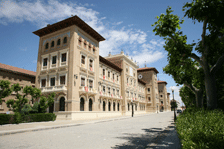
AGM Third Epoch -
La Bandera
The ColorsAs the Academia General Militar didn’t have its own Colors at the very beginning it chose the Colors that belonged to the Infantry Academy. In 1885 Queen Maria Cristina de Habsburgo embroidered the original Colors cloth and it was handed to the Academy on July 17th 1886. The Colors was embroidered with the following inscription,“S.M. la Reina Maria Cristina a la Academia General”(Her Majesty Queen María Cristina to the Academia General Militar).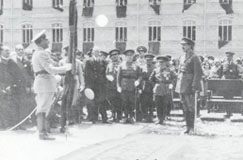
His Majesty King Alfonso XIII handed the Colors to the AGM on the 2nd Epoch reopening.The Colors along with its streamers – as well as its old Colors cloth - are watched over in the Colors Hall of the Academia General Militar. This Colors has been kissed by thousands of Spaniards with intense emotion following General Galbis’s wise words,
“Quien sirva en esta Academia y jure esta Bandera, aunque quiera ser traidor no podrá serlo nunca”(“Those who serve this Academy and swear allegiance to this Flag, can’t become traitors even if they want to become so”).



